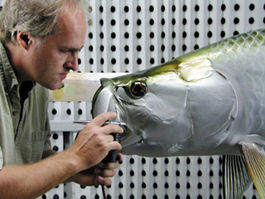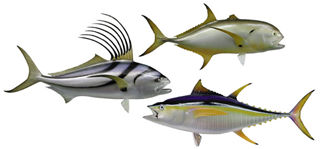
It's almost impossible to forget my first big dolphin, especially when I sit down to write my monthly column. That's because the colorful beast constantly stares down at me from its home on my office wall, a vivid reminder of our epic battle so many years ago.
On that celebrated day, my cousin and I, adventurous teenagers at the time, had taken the family's 23-foot center console some 20 miles east of North Miami Beach's Haulover Inlet. After reaching blue water we picked up a textbook-perfect weed line and began trolling ballyhoo through the pancake-flat seas.
Nothing happened until mid-morning, when a big bull struck the port flat line. After a spectacular jump, the fish sounded and remained deep for most of the fight. Spurred by thoughts of fame and glory, I applied as much pressure as the 20-pound tackle would take. Thirty minutes later I had the dolphin within gaffing range. My cousin did the honors, but wasn't prepared for the fish's explosive reaction when it felt the steel. I could only watch helplessly as he lost his balance and fell onto the gunwale in what proved to be an unsuccessful attempt to keep the dolphin from wrestling the gaff out of his hands. My cousin eventually recovered from the incident, but the gaff did not. It floated back to the surface, badly bent.
Another 15 minutes passed before I was again able to lead the exhausted dolphin alongside the boat. Armed with a gaff we had borrowed from a nearby boat, my cousin stuck the fish again and swung it into the cockpit. Victory at last! The taking of that 30-pound fish was quite an exciting achievement for a pair of inexperienced teenagers, and I'm reminded of our adventure every time I look at that fish on my office wall.
In addition to rekindling fond memories, recognizing a major angling achievement or simply getting you charged up for your next fishing trip, a mounted fish is a guaranteed attention-grabber. Don't think so? When was the last time you failed to notice a mounted fish on display in a restaurant, marina, tackle shop or friend's home?
Fiberglass Saves Fish
These days, having a fish mounted is easier than ever before. Better still, the fish doesn't even have to be killed! Unlike years past, when the entire fish or some parts were used to create a mount, modern fish taxidermy is now progressing towards 100-percent fiberglass reproductions. Benefits include the conservation of fish, followed by the durability and variety offered by pure fiberglass replicas. The conservation aspect may not seem important with fish such as dolphin, striped bass, tuna or other edible species, but fiberglass taxidermy makes a lot of sense when it comes to billfish, sharks, barracuda and other fish not destined for the table.
It should be noted that some taxidermists still offer pure skin mounts and partial reproductions, wherein the tail, fins, teeth and other parts of the original fish are used. The disadvantage of skin mounts, which now make up a very small percentage of marine replicas, is that the skin can crack, exude oil, and become discolored over time. The same can happen to the natural parts used in partial mounts. Besides, in many cases the skin is painted or highlighted to match the original colors and tones.

With the dolphin mentioned above, I chose to have the original tail and fins incorporated into the mount, having filleted the fish and kept the meat. I did the same a few years later with an 82-pound sailfish, which had a unique curved bill that I wanted to incorporate into the mount. Again, I kept the meat and had it smoked. I used a very popular South Florida taxidermist, who did a beautiful job. However, the tails and fins on both mounts have been cracking and peeling for years, despite their being kept indoors since I took possession.
Release Mounts
"Our concept is to encourage marine conservation through the promotion of our release mounts," says Raymond Douglas of King Sailfish Mounts in Pompano Beach, Florida [(888) 724-5347]. "We encourage anglers to release their trophy fish alive and to commemorate their catch by displaying a 100-percent fiberglass replica. So, naturally, we do not accept the fresh fish. During the eight years we've been in business, we have encouraged thousands of anglers to release their catches alive."
King Sailfish specializes in a wide variety of marine fish replicas. Their release mounts are extremely realistic and highly detailed. They have an extensive inventory of molds of the most popular species in a wide variety of sizes and poses. "Our molds are made from well-proportioned fish," says Douglas. "The casting is so important. That's where the finer details such as the scales, lateral line, fin spines and other surface details are reproduced. Equally important is the positioning of the eyes and fin angles, and the painting."
To obtain a King release mount, simply measure and release the fish, then call in the information. King Sailfish will then select the replica mold that matches the fish's dimensions from its inventory and ship it off.
"What makes our company different from our larger competitors is our marketing approach," says Douglas. "In order to encourage marine conservation, we do not provide incentive (e.g., commissions) to charter captains, a practice that can lead to abusive selling tactics, often at the expense of the resource. We sell the majority of our mounts directly to the angler. Our prices do not support charter captain commissions, and are therefore somewhat lower than average."
Mounts Made to Order
J.T. Reese, which has been around since 1938, has recently changed owners and management. Joe Ribera, shop manager for the popular Fort Lauderdale-based taxidermist, claims the company was originally built on skin mounts, but over the years has shifted its effort to creating predominantly fiberglass replicas. "There's no point in killing fish to mount anymore," says Ribera. "We have about 2,000 skin mounts that were left in inventory when we took over, mostly sailfish and marlin. When we burn those out, that's it. People are coaxed to kill fish and there's no need for that. To promote marine conservation, J.T. Reese now offers a 15-percent price reduction to those customers who release the fish they want mounted."
According to Ribera, J.T. Reese has over 2,500 molds in inventory, which allows them to match the exact size and shape of almost any fish. "If we're not dead on with the length, we're usually within a few inches of it," says Ribera. "We can then split the belly, stretch the tail or use other techniques to make it fit the exact measurements of a customer's fish.
"I believe that one of the most important things in achieving a quality mount is the painting. Take dolphin, for instance. No two fish look alike. So why should we use one paint scheme for every one we mount? I strongly encourage customers to take photos of their fish prior to its release, or right after it has been boated. We'll match any kind of spot patterns, rather than "assembly line" the fish. We had one customer bring in a dolphin with a shark bite on its dorsal. When we made the fiberglass replica, we etched out the shark bite. J.T. Reese was built on adding the personal touch to a mount, and we're keeping to that commitment."
Gray Taxidermy, considered the world's largest marine taxidermist, claims the details within the molds and paint schemes are what make a realistic mount. "We don't use 40-year-old molds," says Ian Hall, vice president of the Pompano Beach, Florida-based company. "As we learn new tricks of the trade, we upgrade our molds in order to maintain the details, such as scales, muscles and lateral lines. Once the details in a mold start to fade, we'll upgrade the mold. Colors are just as important. Our artists have been aware of this for many years, yet we're always tweaking and trying to make our finishes look even better. We've been playing with kingfish lately. That's the hardest fish to make look alive, but we're right there."
Accordingly to Hall, Gray has been in business for 36 years, and last year the company produced over 12,000 fish mounts. He claims that complete fiberglass reproductions comprise some ten percent of its business, although that number is "really building." "A lot of people still don't know about [all-fiberglass mounts]," says Hall. "The more they're educated, the larger that percentage will increase." Partial reproductions, wherein the original fins, tails and other body parts are used in conjunction with a fiberglass replica, make up 89 percent of the business, while the old-fashioned skin mounts are a mere one percent.
Phone-In Fish
Mounting a fish has never been easier from an angler's standpoint. If you hook and fight a trophy fish to the boat and decide to have it mounted, take its measurements and a few photographs, then release it. A few years ago I caught and released a big snook with the intention of having it mounted. Once the fish was led alongside the boat, we weighed it on a scale and carefully laid it on a wet gunwale. Using a pencil, I marked where the tip of its tail and lower jaw rested, then released the fish. When we returned home, I used a measuring tape to determine the exact length and then called the taxidermist to order a fiberglass replica of that 43-inch, 30-pound snook -- facing left. It's a beauty!
Billfish, sharks and other sizable pelagics are more challenging. Once again, you can lead them along side the boat and mark off their approximate measurements, or use a measuring tape if they're docile. You may not be 100-percent on the money, but you'll get very close. And what's an inch or two when you can release the fish?
Thanks to modern fish-mounting, techniques anglers fortunate enough to hook, beat and release a trophy fish can now preserve a special memory or fishing feat with a reproduction mount. It's the perfect situation, one in which and everyone comes out a winner. Including the fish.
FOR MORE INFORMATION ON RELEASE MOUNTS:
KING SAILFISH MOUNTS - http://kingsailfishmounts.com
(888) 724-5347

